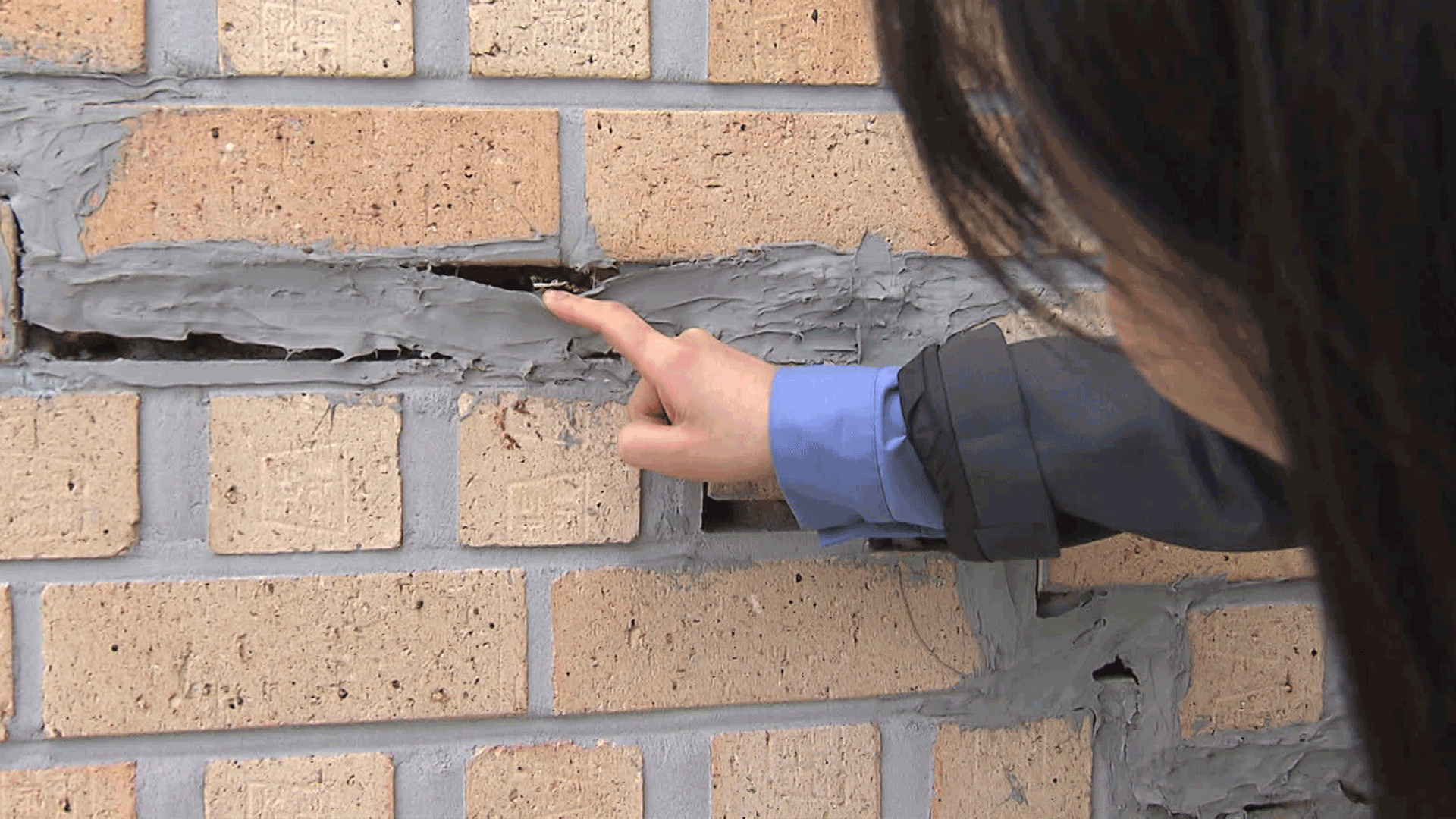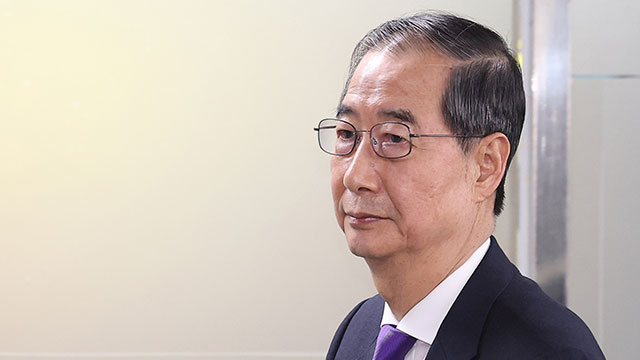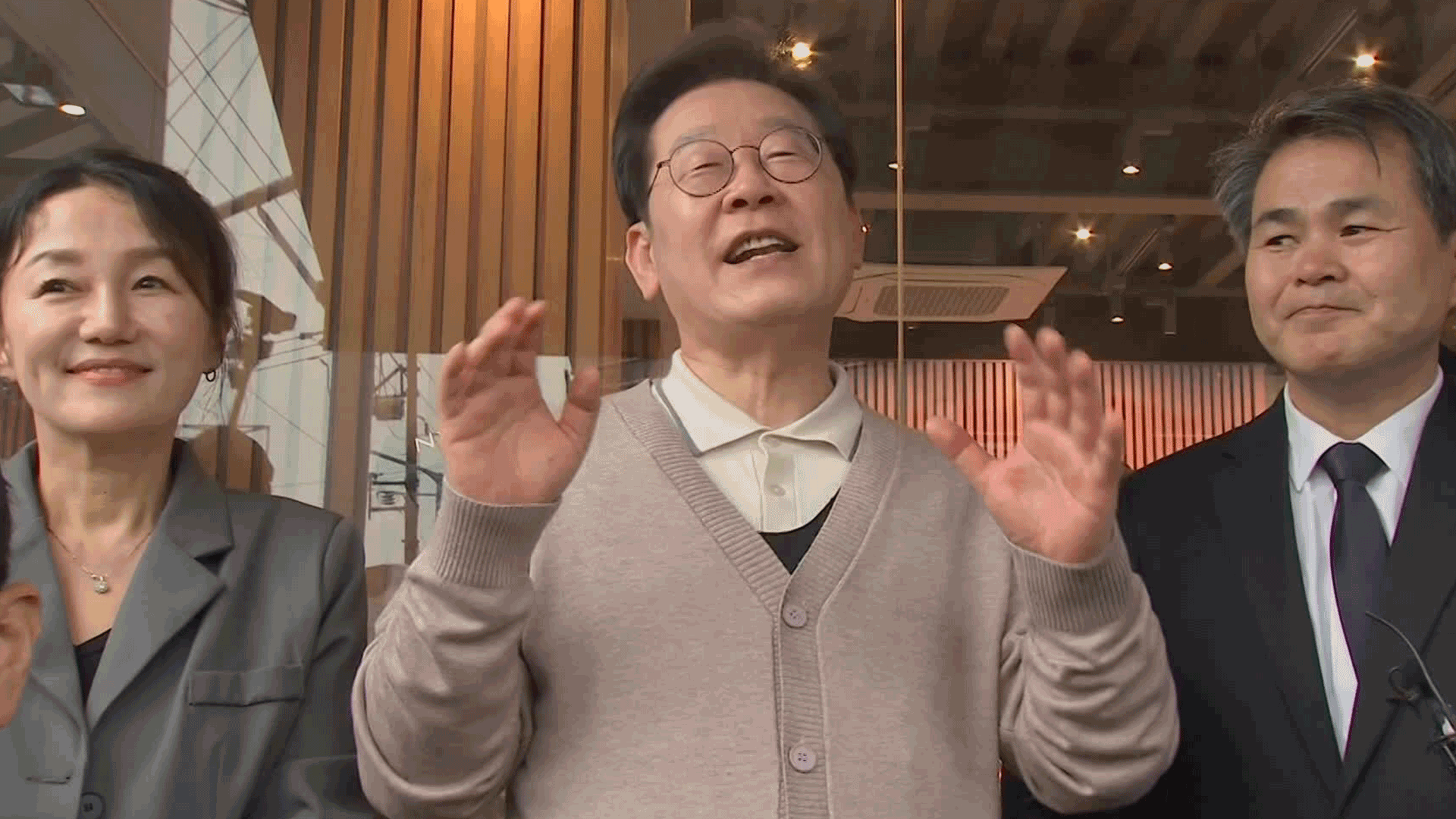[Anchor]
Ground subsidence has been confirmed at Muan International Airport in Jeonnam Province.
The subsidence is occurring due to construction work for an underground tunnel to connect the airport with the high-speed railway, causing the ground in various areas of the airport to sink.
In a year and a half, it has sunk by 1 cm.
First, we have a report from reporter Lee Ji-eun.
[Report]
This is the cargo terminal of Muan International Airport.
A facility for storing power supply devices has tilted to one side.
Silicone has been applied to the cracks and gaps in the fence.
[Muan International Airport Official/Voice Altered: "Gradually, (cracks have formed). We requested measures and repairs have been made. (Soon) everything will be demolished...."]
The cracks began to appear three years ago, after the construction of the high-speed railway connecting Gwangju and the airport started.
This is the fence next to the passenger terminal, about 100 meters away from the construction site.
The width of the cracks caused by excavation and blasting has increased by 0.5 cm in just six months.
Blasting work to create the underground tunnel has been conducted over 890 times in the past two years.
When measuring the degree of ground subsidence at the tunnel construction site, it was found that it had sunk by 0.9 cm by September of last year, and an additional 0.1 cm has sunk in just four months.
In a year and a half, it has sunk by 1 cm.
[Park Chang-geun/Professor of Civil Engineering at Catholic Kwandong University: "It has sunk about 1 cm from a location about 100 meters away from the construction site, but more importantly, the closer you get to the construction site, the greater the amount of subsidence."]
The construction uses the 'NATM (New Austrian Tunneling Method)' technique, the same method used in the ground subsidence in Gangdong-gu, Seoul, and the Shinansan Line collapse site.
This method utilizes the ground's bearing capacity to blast the tunnel, but Muan International Airport is built on soft ground consisting of tidal flats and reclaimed land, so caution is needed.
The Korea National Railway states that the depth of subsidence does not exceed the standard of 1.5 cm, so there is no problem.
[Jo Won-cheol/Emeritus Professor of Construction Environmental Engineering at Yonsei University: "This is not something that will end this year; it will continue to progress. It could easily exceed 3 cm. Weak spots will inevitably occur somewhere."]
The Korea National Railway has stated that it cannot definitively conclude that the building cracks are due to the construction and will measure and report the degree of ground subsidence around the airport every month.
This is KBS News, Lee Ji-eun.
Ground subsidence has been confirmed at Muan International Airport in Jeonnam Province.
The subsidence is occurring due to construction work for an underground tunnel to connect the airport with the high-speed railway, causing the ground in various areas of the airport to sink.
In a year and a half, it has sunk by 1 cm.
First, we have a report from reporter Lee Ji-eun.
[Report]
This is the cargo terminal of Muan International Airport.
A facility for storing power supply devices has tilted to one side.
Silicone has been applied to the cracks and gaps in the fence.
[Muan International Airport Official/Voice Altered: "Gradually, (cracks have formed). We requested measures and repairs have been made. (Soon) everything will be demolished...."]
The cracks began to appear three years ago, after the construction of the high-speed railway connecting Gwangju and the airport started.
This is the fence next to the passenger terminal, about 100 meters away from the construction site.
The width of the cracks caused by excavation and blasting has increased by 0.5 cm in just six months.
Blasting work to create the underground tunnel has been conducted over 890 times in the past two years.
When measuring the degree of ground subsidence at the tunnel construction site, it was found that it had sunk by 0.9 cm by September of last year, and an additional 0.1 cm has sunk in just four months.
In a year and a half, it has sunk by 1 cm.
[Park Chang-geun/Professor of Civil Engineering at Catholic Kwandong University: "It has sunk about 1 cm from a location about 100 meters away from the construction site, but more importantly, the closer you get to the construction site, the greater the amount of subsidence."]
The construction uses the 'NATM (New Austrian Tunneling Method)' technique, the same method used in the ground subsidence in Gangdong-gu, Seoul, and the Shinansan Line collapse site.
This method utilizes the ground's bearing capacity to blast the tunnel, but Muan International Airport is built on soft ground consisting of tidal flats and reclaimed land, so caution is needed.
The Korea National Railway states that the depth of subsidence does not exceed the standard of 1.5 cm, so there is no problem.
[Jo Won-cheol/Emeritus Professor of Construction Environmental Engineering at Yonsei University: "This is not something that will end this year; it will continue to progress. It could easily exceed 3 cm. Weak spots will inevitably occur somewhere."]
The Korea National Railway has stated that it cannot definitively conclude that the building cracks are due to the construction and will measure and report the degree of ground subsidence around the airport every month.
This is KBS News, Lee Ji-eun.
■ 제보하기
▷ 카카오톡 : 'KBS제보' 검색, 채널 추가
▷ 전화 : 02-781-1234, 4444
▷ 이메일 : kbs1234@kbs.co.kr
▷ 유튜브, 네이버, 카카오에서도 KBS뉴스를 구독해주세요!
- Ground sinks at Muan Airport
-
- 입력 2025-05-10 00:32:45

[Anchor]
Ground subsidence has been confirmed at Muan International Airport in Jeonnam Province.
The subsidence is occurring due to construction work for an underground tunnel to connect the airport with the high-speed railway, causing the ground in various areas of the airport to sink.
In a year and a half, it has sunk by 1 cm.
First, we have a report from reporter Lee Ji-eun.
[Report]
This is the cargo terminal of Muan International Airport.
A facility for storing power supply devices has tilted to one side.
Silicone has been applied to the cracks and gaps in the fence.
[Muan International Airport Official/Voice Altered: "Gradually, (cracks have formed). We requested measures and repairs have been made. (Soon) everything will be demolished...."]
The cracks began to appear three years ago, after the construction of the high-speed railway connecting Gwangju and the airport started.
This is the fence next to the passenger terminal, about 100 meters away from the construction site.
The width of the cracks caused by excavation and blasting has increased by 0.5 cm in just six months.
Blasting work to create the underground tunnel has been conducted over 890 times in the past two years.
When measuring the degree of ground subsidence at the tunnel construction site, it was found that it had sunk by 0.9 cm by September of last year, and an additional 0.1 cm has sunk in just four months.
In a year and a half, it has sunk by 1 cm.
[Park Chang-geun/Professor of Civil Engineering at Catholic Kwandong University: "It has sunk about 1 cm from a location about 100 meters away from the construction site, but more importantly, the closer you get to the construction site, the greater the amount of subsidence."]
The construction uses the 'NATM (New Austrian Tunneling Method)' technique, the same method used in the ground subsidence in Gangdong-gu, Seoul, and the Shinansan Line collapse site.
This method utilizes the ground's bearing capacity to blast the tunnel, but Muan International Airport is built on soft ground consisting of tidal flats and reclaimed land, so caution is needed.
The Korea National Railway states that the depth of subsidence does not exceed the standard of 1.5 cm, so there is no problem.
[Jo Won-cheol/Emeritus Professor of Construction Environmental Engineering at Yonsei University: "This is not something that will end this year; it will continue to progress. It could easily exceed 3 cm. Weak spots will inevitably occur somewhere."]
The Korea National Railway has stated that it cannot definitively conclude that the building cracks are due to the construction and will measure and report the degree of ground subsidence around the airport every month.
This is KBS News, Lee Ji-eun.
Ground subsidence has been confirmed at Muan International Airport in Jeonnam Province.
The subsidence is occurring due to construction work for an underground tunnel to connect the airport with the high-speed railway, causing the ground in various areas of the airport to sink.
In a year and a half, it has sunk by 1 cm.
First, we have a report from reporter Lee Ji-eun.
[Report]
This is the cargo terminal of Muan International Airport.
A facility for storing power supply devices has tilted to one side.
Silicone has been applied to the cracks and gaps in the fence.
[Muan International Airport Official/Voice Altered: "Gradually, (cracks have formed). We requested measures and repairs have been made. (Soon) everything will be demolished...."]
The cracks began to appear three years ago, after the construction of the high-speed railway connecting Gwangju and the airport started.
This is the fence next to the passenger terminal, about 100 meters away from the construction site.
The width of the cracks caused by excavation and blasting has increased by 0.5 cm in just six months.
Blasting work to create the underground tunnel has been conducted over 890 times in the past two years.
When measuring the degree of ground subsidence at the tunnel construction site, it was found that it had sunk by 0.9 cm by September of last year, and an additional 0.1 cm has sunk in just four months.
In a year and a half, it has sunk by 1 cm.
[Park Chang-geun/Professor of Civil Engineering at Catholic Kwandong University: "It has sunk about 1 cm from a location about 100 meters away from the construction site, but more importantly, the closer you get to the construction site, the greater the amount of subsidence."]
The construction uses the 'NATM (New Austrian Tunneling Method)' technique, the same method used in the ground subsidence in Gangdong-gu, Seoul, and the Shinansan Line collapse site.
This method utilizes the ground's bearing capacity to blast the tunnel, but Muan International Airport is built on soft ground consisting of tidal flats and reclaimed land, so caution is needed.
The Korea National Railway states that the depth of subsidence does not exceed the standard of 1.5 cm, so there is no problem.
[Jo Won-cheol/Emeritus Professor of Construction Environmental Engineering at Yonsei University: "This is not something that will end this year; it will continue to progress. It could easily exceed 3 cm. Weak spots will inevitably occur somewhere."]
The Korea National Railway has stated that it cannot definitively conclude that the building cracks are due to the construction and will measure and report the degree of ground subsidence around the airport every month.
This is KBS News, Lee Ji-eun.
-
-

이지은 기자 written@kbs.co.kr
이지은 기자의 기사 모음
-
이 기사가 좋으셨다면
-
좋아요
0
-
응원해요
0
-
후속 원해요
0















이 기사에 대한 의견을 남겨주세요.